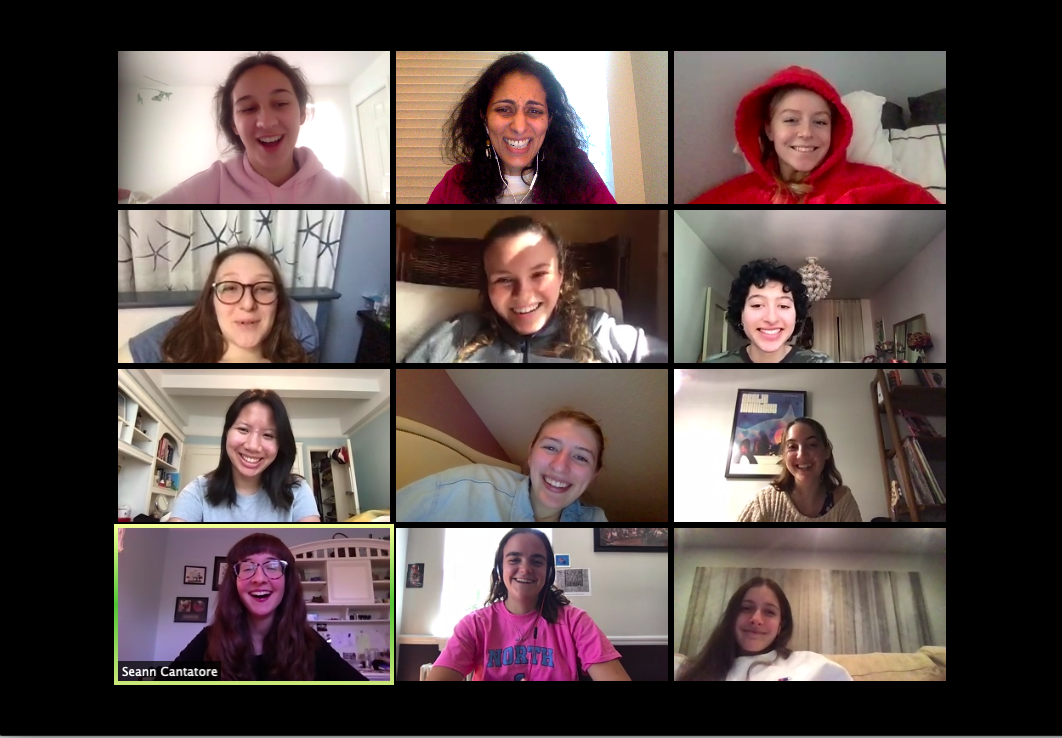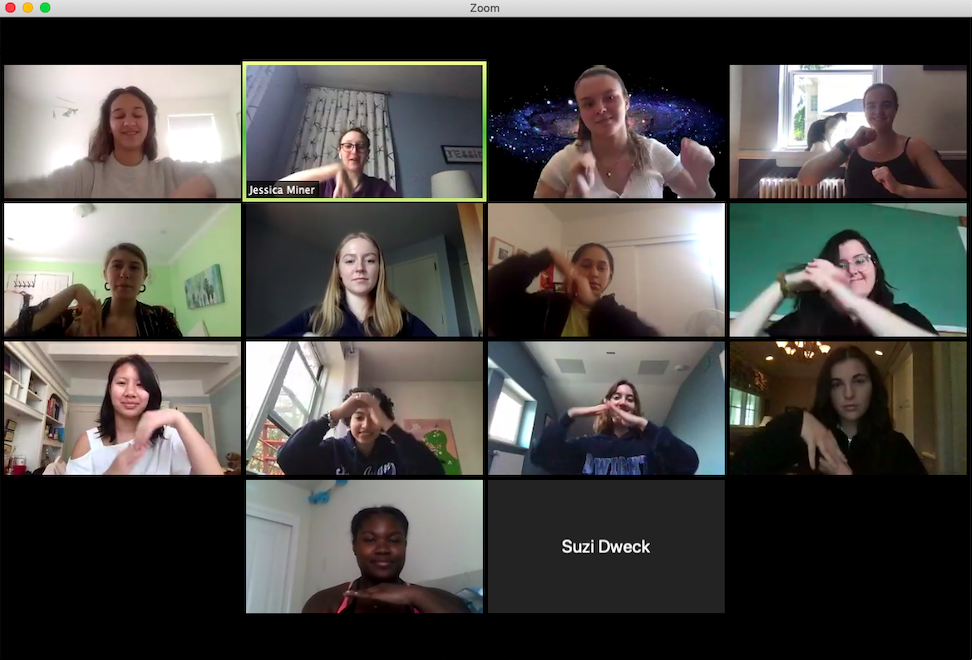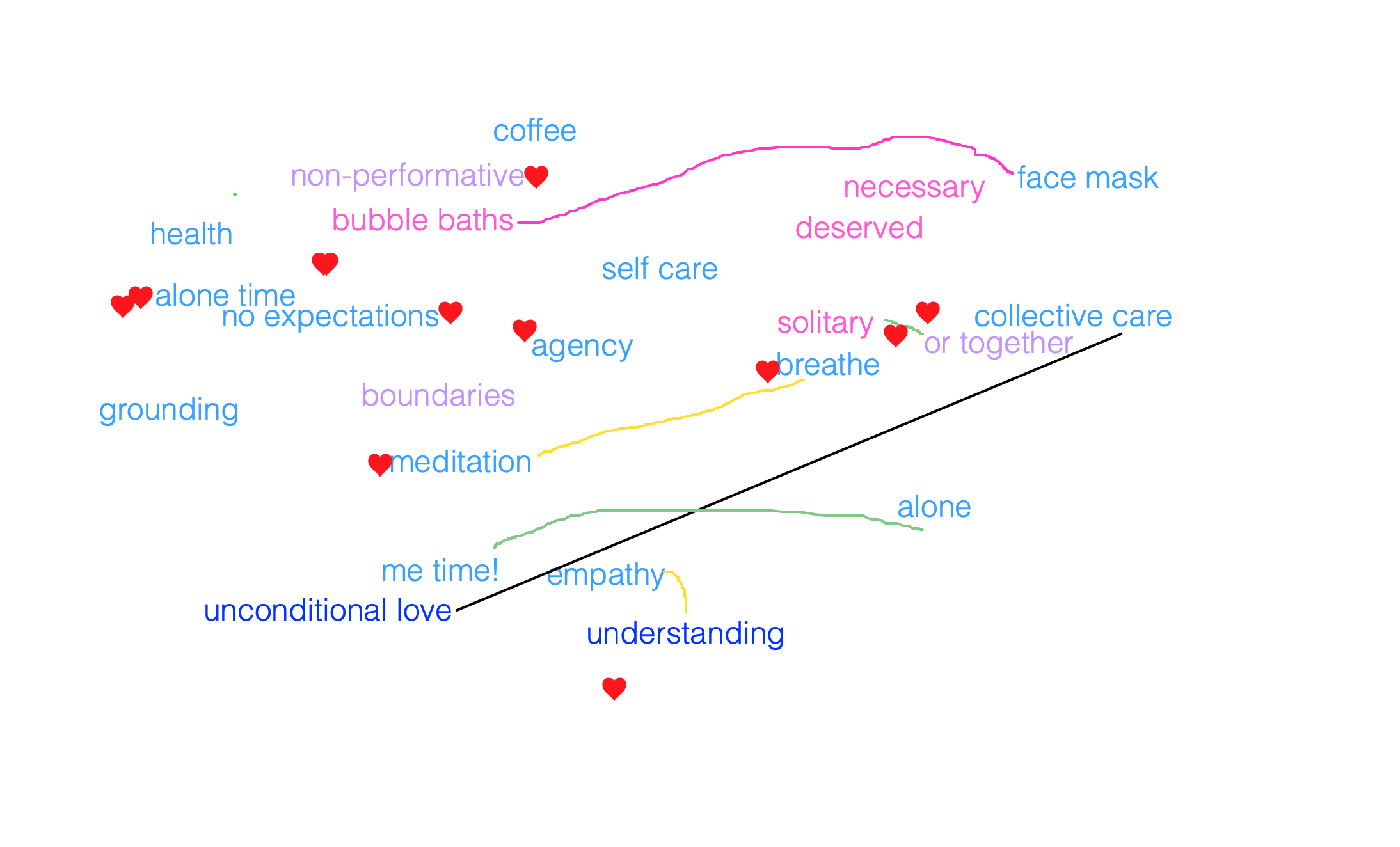Interview with Nina Sharma, Adjunct Associate Professor of English
 The current pandemic and #CovidCampus context that we now face happened quickly and is without precedent in terms of schools and universities needing to continue almost every aspect of their work online. Please describe how you have navigated transitioning your courses, your pedagogical approach and your classroom/student community online. Please address both challenges and what has been working well for you and your students.
The current pandemic and #CovidCampus context that we now face happened quickly and is without precedent in terms of schools and universities needing to continue almost every aspect of their work online. Please describe how you have navigated transitioning your courses, your pedagogical approach and your classroom/student community online. Please address both challenges and what has been working well for you and your students.
This semester I’m teaching First-Year Seminar and First-Year Writing, my class theme for both courses is “Women and Comedy.” I’ve been teaching first-years for nearly ten years, but this year was my first at Barnard and it has been a unique teaching experience for a few reasons. I’m a Barnard alumna myself. I came in as a transfer and spent most of my time on 4th floor Barnard Hall as an English major. That immediate connection is very powerful. What my students don’t know is that we share something else in common. My very first year of college, a friend of mine was murdered by a serial killer. Her murder made the national news and was the subject of shows like America’s Most Wanted. I never dealt with my grief in school and never even really shared it. I thought of grief like an impolite interruption to the academic experience. Come this semester, I knew I wanted my classes to be spaces where students felt they could express feelings and could regard feelings not like I did, unwelcomed interruptions, but as creative interventions and intellectual opportunities. I call this a feelings-centered approach to craft, which I had already been developing through my years of running my community writing workshop, “No Name Mind: Stories of Mental Health from the Margins.” I have been running NNM at The Asian American Writers’ Workshop with funding awarded from Asian Women Giving Circle and it is now part of Barnard’s Pre-College Summer Programs.
Even without the trauma of violent death and the stress of a global pandemic, the first-year of college is its own tumultuous time, to put it mildly. What I have loved seeing through teaching FYW and FYS is how the students have real space to not only hone writing and discussion skills but to claim an intellectual life for themselves and an intellectual community with one another. In both of my classes, I was struck by how many students on the very first day said some version of “I’m looking forward to getting close to everyone.” They immediately saw writing and discussion as acts of intimacy and community-building. This in turn empowered me to bring my feelings-centered pedagogy into the classroom.
Instead of “funny” we focused on the “fun” of the story – that fun differing from text to text, from Tina Fey’s Bossypants to Jamaica Kincaid’s A Small Place to Sara Ahmed’s Feminist Killjoys. I always say that sometimes the “fun” of the story is that we have survived, that we are surviving. “Women and Comedy” became a place for them to explore their own uncommon notions of fun.
 I was in fact with my students on a field trip to a comedy show when the news broke. On the Sunday before we went online, I took them to the Magnet Improvisation Theater to see Seann Cantatore’s one-woman variety show, Sawwwry I’m Late!!! It would be the last time I would see my students in person this semester. As we milled in the lobby, waiting for the show to begin, I saw phones light up. One student held her phone out to me. I skimmed the email from Provost Bell announcing that Barnard was suspending classes on Monday and Tuesday, and offering classes virtually for the remainder of that week, as in up to spring break.
I was in fact with my students on a field trip to a comedy show when the news broke. On the Sunday before we went online, I took them to the Magnet Improvisation Theater to see Seann Cantatore’s one-woman variety show, Sawwwry I’m Late!!! It would be the last time I would see my students in person this semester. As we milled in the lobby, waiting for the show to begin, I saw phones light up. One student held her phone out to me. I skimmed the email from Provost Bell announcing that Barnard was suspending classes on Monday and Tuesday, and offering classes virtually for the remainder of that week, as in up to spring break.
“How long do you think this will be?” the student asked “Are we ever coming back?”
“How many weeks worth of clothes I should pack?” asked her friend.
I gave my best estimate. “Three weeks.”
Then the theater doors opened and we literally went on with the show.
 On Monday, First-Year Writing was my first Zoom class. I made it simple. My plan was to practice Zoom functions, mute and unmute, hand raise, share screen, as we talked about Seann Cantatore’s show. Each student spoke up, more than they sometimes do in the classroom, opinions that connected, differed, affirmed, challenged. We talked poop jokes and the power of a woman telling them. We took notes on a shared Google doc and posed possible questions we’d ask Seann. Every single one of them talked. They were surviving, they were having fun. I knew I wanted to keep distilling classes to what was essential, to make sure I could hear from as many of them as possible.
On Monday, First-Year Writing was my first Zoom class. I made it simple. My plan was to practice Zoom functions, mute and unmute, hand raise, share screen, as we talked about Seann Cantatore’s show. Each student spoke up, more than they sometimes do in the classroom, opinions that connected, differed, affirmed, challenged. We talked poop jokes and the power of a woman telling them. We took notes on a shared Google doc and posed possible questions we’d ask Seann. Every single one of them talked. They were surviving, they were having fun. I knew I wanted to keep distilling classes to what was essential, to make sure I could hear from as many of them as possible.
Please describe what pedagogical innovations/creative solutions you are working on or plan to create as part of instructional continuity with your students. Feel free to point to helpful resources you have created (alone or with other faculty) and any other resources that you have found particularly positive and helpful to you and your students.
The most helpful resource has been my fellow teachers. The regular meetings and information sharing that my colleagues generously do in First-Year Experience helps to sort out the complications of last-minute distance learning. Even if we are self-isolating, we are not alone. The more we can affirm this among ourselves, the more it translates to our students.
One of the first things I did was adapt a survey that my colleagues Cecelia Lie-Spahn and Andrew Lynn offered to their students as we transitioned. The survey asked a range of questions - from “where are you located” and “what is your time zone/s” to “what difficulties could you imagine going forward” and “what do you want out of the rest of the semester.” The student responses really helped me as I revised my course plans, determining where to stay the course, where to adjust and test and try new plans.
I also continue to work with my wonderful FYW writing fellows, Elana Rebitzer and Ruchi Shah and my FYS speaking fellow, Xiaoming Zhang. I am grateful for our enduring connection. I chatted with all my fellows to brainstorm how to alter our plans going forward. At the end of March, Elana and Ruchi discussed the needs the students expressed to them during their student conferences. Xiaoming made a lesson plan that specifically addressed public speaking in a virtual world.
Outside of school, I study improv comedy and I had already been pulling improv into the classroom. On our extended break, I took a class with one of the Magnet Theater’s improv teachers, Elana Fishbein. The class, “Online Facilitation Workshop for Theater and Improv Teachers,” was specifically geared towards educators and had a variety of folks – teachers, social workers, performers, etc. We were 26 people each sitting at our own home computer, but by the end of the class, I felt like we were in a very intimate discussion space. Improv is nothing but seeing interruption as opportunity. Elana’s class asked us to have a relationship with the “frame” – the frame of the computer screen, the Zoom square you are in. Where is the frame? And what is your relationship with it? I feel like these were the guiding questions we explored through improv exercises. As we did, I felt like we were bending our frames, those 26 boxes, even making them fall away entirely. I knew I wanted to do that for my students.
 Almost every class, I start with an improv game and sometimes do one midway through or at the end. These games are simple warm ups, often called “focus warm ups.” They aren’t about being funny. I love how Elana described them as coming into a “new way of focusing,” building a sense of “right of way” at a “26-way intersection,” or in my case a 16-way one. Our short scene exercises build on these focus games, helping us create a low-risk space to share thoughts and go over various discussion scenarios: what happens when we speak over each other? when is interruption okay? when do we pause and negotiate? Improv is always great at creating a shared space, a sense of trust in one another so we can do our best work.
Almost every class, I start with an improv game and sometimes do one midway through or at the end. These games are simple warm ups, often called “focus warm ups.” They aren’t about being funny. I love how Elana described them as coming into a “new way of focusing,” building a sense of “right of way” at a “26-way intersection,” or in my case a 16-way one. Our short scene exercises build on these focus games, helping us create a low-risk space to share thoughts and go over various discussion scenarios: what happens when we speak over each other? when is interruption okay? when do we pause and negotiate? Improv is always great at creating a shared space, a sense of trust in one another so we can do our best work.
Sometimes when my students and I play a game, I see a student turn away to explain to a parent what’s happening, why she is bending her body like a teapot for instance. The parent can’t see that there are 15 other teapots joining her and that we will all sit and talk about thesis statements in a moment. These games are meaningless, necessarily so – the “don’t think” part of improv. And yet, as we play them, I see a transfer into the work we do. As educators, the worry is how to replicate a collective understanding of a text or craft. The worry is what happens when the sound is off or a parent or sibling walk through or grief hangs heavy over us all. With improv, interruptions of all sorts are the “gifts” of the scene. As we do these exercises as a class, I think we become less self-conscious over the interruptions that come up and can keep focus.
I also just fundamentally think about timing. How can our session be more than shared screen time? I’ve been thinking about how in online learning we experience time in many ways all at once. We can be in an intense 20-minute discussion of a text together while your Dad might be, in that same space and time, making a leisurely ham sandwich. And we are in many different time zones and phases of our day. I think about how to be in agreement. How can this session be more than a 75-minute conference call? How can we agree upon how we spending our time today? This means something different session to session and group to group. In FYW, we spend some time away from the screen doing timed writing exercises. In FYS, we mix things up with large group discussion and small group break out rooms.
It’s also been important to me to create time for students to simply express excitement for each other’s work. Once, after opening up class with an improv game called “I Love It,” my students discussed how the game called “excitement” into the room. We began to discuss “excitement” as part of the intellectual experience and how it’s okay to have that feeling even amid the sadness, fear and anger we can feel at this time. I generally think as women it’s easier and perhaps more socially acceptable to say “I’m nervous” than “I’m excited.” I allot at least 2 classes to be large group, full 16-person shares. One-by-one, the entire class simply affirms each student’s project, naming what they love and what they see as a writer’s strengths. After those classes, students seemed the most amped to keep going. When I can’t fit those large shares into the lesson plan, I use the discussion boards to be a similar low-stakes affirmation space. They always have each other’s back.
When everything went down, I turned to my most enduring teaching practices, from years of running community writing workshops. In my community writing workshops, my lessons plans are equal parts activity-based and discussion-centered. This sometimes is called flipping the classroom, but it has always felt more like a natural structure to me. In both my FYW and FYS classes, I allot considerable time to both in-class writing and discussing process of research and revision. With the pressure of grades removed, I’ve asked my students to center process, get granular with reflecting on the experience of moving through the stages of research and revision – what are the questions they ask of themselves? of the texts they engage with? of each other? how do these questions change or deepen as they progress with their project? My hope always is that student value process just as much as product. And now I think the more we can process together, the better off we can feel in our corners of the world.
Could you share a couple of examples either of 1. Particularly interesting research that your students are working on and have been working on successfully since the move online and/or 2. Some insights/’pleasant surprises’ about your courses, your approach to teaching, your students and classroom dynamic that have emerged and are emerging.
 For our First-Year Writing library session, we had Barnard research librarian Vani Natarajan come speak with us. Vani came to us at an usual time, not only because of Covid-19 but because, through the shift in timing, the students had already collected their sources. Prior to the session, Vani and I discussed the session as being a way for the students to develop strategies for using the sources they have already found, to position themselves in a conversation, and to look at citations and trace what a conversation has looked like for them thus far. Vani did a very cool exercise using Zoom’s whiteboard function where the students collaboratively made a key term word cloud. They then walked us through how to use CLIO in a variety of ways, from the starting point of the students' own key terms to dynamic key terms searches that open up to a world of sources and more language. The next class, my students discussed how the session made research more tangible and concrete for them. One student said the word cloud helped her think through what's important in her argument, what she really wants to say and how to curate research work from there. Another student said that she otherwise had a very static relationship with CLIO – “don’t have a book, bye.” A few others said they never before used CLIO. All to say, the frame, in this case the CLIO search box, fell way. CLIO was no mere search engine but became, to use one of our class terms, an Alice-in-Wonderland-rabbit-hole.
For our First-Year Writing library session, we had Barnard research librarian Vani Natarajan come speak with us. Vani came to us at an usual time, not only because of Covid-19 but because, through the shift in timing, the students had already collected their sources. Prior to the session, Vani and I discussed the session as being a way for the students to develop strategies for using the sources they have already found, to position themselves in a conversation, and to look at citations and trace what a conversation has looked like for them thus far. Vani did a very cool exercise using Zoom’s whiteboard function where the students collaboratively made a key term word cloud. They then walked us through how to use CLIO in a variety of ways, from the starting point of the students' own key terms to dynamic key terms searches that open up to a world of sources and more language. The next class, my students discussed how the session made research more tangible and concrete for them. One student said the word cloud helped her think through what's important in her argument, what she really wants to say and how to curate research work from there. Another student said that she otherwise had a very static relationship with CLIO – “don’t have a book, bye.” A few others said they never before used CLIO. All to say, the frame, in this case the CLIO search box, fell way. CLIO was no mere search engine but became, to use one of our class terms, an Alice-in-Wonderland-rabbit-hole.
Before we went online, I had titled the FYW research unit: “Research Essay as One-Woman Variety Show.” I introduced the unit long before I knew we would all be on our own. It has been interesting to see how the students continue to insist on their topics – be it the “fun” of vulgar humor by women or veganism from the margins and especially how they insist on their own position on the questions they raise. My students have always talked about the struggle to feel an “equal share” in a scholarly conversation. I think in this time where so much of our inside life is now on a public stage – our bedrooms, our backyards, our kitchens, our family members all in plain view – something has shifted. Now, more than ever, research seems like a space for our students to have an inner world, an act of going within and claiming a position amongst their interlocutors.
In FYS, for the third unit, I shifted focus from Women and Comedy to Comedy and Trauma. The students are writing personal essays on their first year of college.
The essays will go in a group anthology that they have named together. I adapted my lesson plans from No Name Mind towards the work my students have been doing thus far. The end point of the unit is to feel comfortable sharing a very personal story with a public. The unit is tiered towards this goal, from a lot of scaffolded group sharing of rough drafts, or as they will say “raw” writing, all the way to polished prose. My seminar brood strangely thrives in the large group. They bust the “break out rooms are better” myth. So, the journey has always been about how personal as a group can we go and how much of a community we can build as we do so. When it came time to name and blurb their anthology, I didn’t need to steer a conversation there. They had already been actively engaging with one another’s work-in-progress and organically came to a collective name and description for their anthology. I think of the seminal feminist anthology This Bridge Called My Back and I think of how in improv, we say, “got your back.” This anthology they are making is somewhere in between the two. It’s the fun of survival.
Please feel free to add anything else that you would like to mention about your courses, your students, your ideas going forward for the rest of the semester.
I came to Barnard as a transfer student who was numb, inarticulate with grief, worried if I’d ever finish college. There had been so many interruptions. When I stepped into my classrooms this semester, I could feel that 21-year old first-year with me. On my first day teaching, a student said, “I’m bothered that when I’m funny, as a woman, I’m not taken seriously.” I knew then that we have all experienced interruption in some way, we have all survived, are surviving, and even now, we’ll find the fun in our stories together.